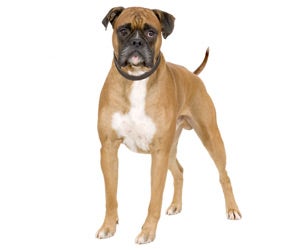Boxer
-
Overview
Boxers are lean but substantial dogs who weigh between 60 and 80 pounds and can stand up to 2 feet tall. These muscle-bound dogs have boundless amounts of energy, but they are also sweet, humorous companions who love spending time with their owners and making them laugh with their exuberance. If you're thrilled about the idea of a dog who will spend hours amusing you and staying close to your side, the Boxer makes a perfect actively involved family companion.
-
Personality
Boxers look seriously quizzical, but especially with their families, they are goofy, playful and extremely loving. It's not uncommon to see Boxers curled up with their owners like lapdogs or initiating spirited games. They are excitable dogs who often prance around the house and exuberantly greet their owners upon their return. Their muscular builds, combined with all that energy, makes them athletic dogs who need quite a bit of exercise and activity to stay occupied and happy.
Boxers' personalities vary. Some are vigilant guard dogs who are wary of strangers and bark to announce unknown visitors. Others are joyful and excitable clowns around strangers, whom they view as potential new friends. The only way to be sure of your Boxer's temperament is to train them consistently, engaging them in fun and firm training games and socializing them with people and other dogs throughout puppyhood. Boxers are generally alert and respond quickly to unfamiliar noises and activities, but providing them with plenty of opportunities for exercise and stimulation will help them calm down indoors.
-
Coat Care
Their short, smooth coat fits Boxers like a glove. Their skin should be taut enough to expose their athletic, sinewy builds. Boxers are either fawn or brindle, with or without white markings along their chests, bellies and feet. Boxers without any white markings are called "plain" and Boxers with extended white on their necks and faces are called "flashy." Brindle Boxers have a pattern of tiger-like stripes over a fawn background. Excessive white markings that cover more than 1/3 of the Boxer's coat are occasionally a sign of poor breeding, because they indicate an increased susceptibility to health problems like deafness and skin cancer. That's why these Boxers aren't permitted in the show ring and should not be bred, but they can still make loving family companions for families who are willing to take on the challenge of a dog with some extra health concerns. Boxers are clean dogs who occasionally clean themselves like cats by licking their paws.

Boxers shed that short hair constantly, and they'll shake it loose themselves by rolling around on your floor and your furniture and rubbing up against you. To cut back on the amount of short hair you find everywhere, brush you Boxer with a bristle brush or a hound glove to remove dead hair and keep their coat looking sleek and shiny. You can use a shedding blade on your Boxer if he's shedding heavily, but be careful not to hurt him, because Boxers' skin is so close fitting and the coat is so short.
With preparation, perseverance and a positive attitude, bathing can become a fun and fulfilling part of the regular grooming cycle, while helping your dog avoid many diseases and infections.
Smooth coated breeds adhere to the general rule of dog bathing: about once every three months. The coat should end up fresh smelling, shiny, with no loose or shedding hair. First give the dog a good brushing to remove dead hair and mats. Place a rubber mat in the tub to provide secure footing and fill the tub with three to four inches of lukewarm water. Use a spray hose, pitcher or unbreakable cup to wet the dog, taking caution to avoid getting water in the eyes, ears and nose. Massage in pet shampoo, saving the head for last. Immediately rinse thoroughly, starting with the head to prevent soap from dripping into the eyes. Towel dry. Wipe wrinkled breeds with a soft cloth and make sure they are totally dry after bathing.
Clipping or trimming your dog’s coat is far easier than you would ever imagine. With the right clipper, trimmer and scissors, giving your dog a haircut is easy on your wallet and your schedule.
Dogs with smooth coats generally only require trims and tidying up in areas of excessive hair growth using a trimmer or blunt scissors. It's always wise to take a dog for a short walk or exercise to calm them down before trimming. Remember to brush the coat first to remove any tangles and mats. Don't forget to trim around the paws, pads, tail, chest and sanitary areas, as needed. The coat should lay flat and smooth against the body when finished.
Boxers need frequent nail clipping, especially because they can be such bouncy, exuberant greeters. Short nails will help everyone stay more comfortable
Check the Boxer's large prick ears at least once a week for infection or loose hair that needs to be trimmed or plucked out.
Boxers need to have their teeth brushed just about every day to avoid dental problems and to keep their breath smelling fresh.

 India (English)
India (English)
 Middle East and Africa (English)
Middle East and Africa (English)
 South Africa (English)
South Africa (English)
 Australia (English)
Australia (English)
 Japan (日本語)
Japan (日本語)
 South East Asia (English)
South East Asia (English)
 Singapore (English)
Singapore (English)
 Europe (English)
Europe (English)
 United Kingdom (English)
United Kingdom (English)
 Argentina (Español)
Argentina (Español)
 Brazil (Portuguese)
Brazil (Portuguese)
 Colombia (Español)
Colombia (Español)
 Latin America (Español)
Latin America (Español)
 México (Español)
México (Español)
 Chile (Español)
Chile (Español)
 Peru (Español)
Peru (Español)
 Canada (English)
Canada (English)

